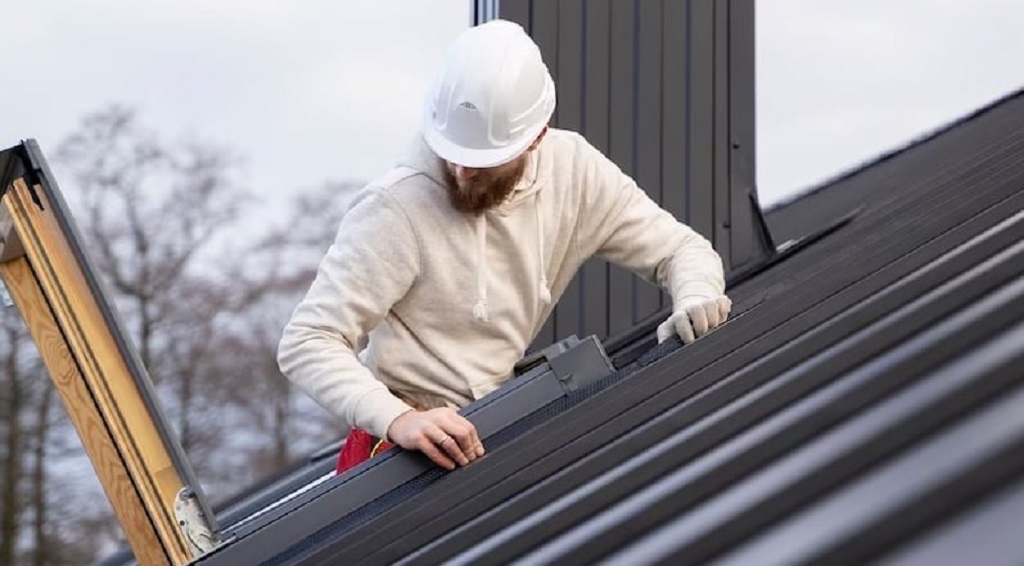Metal Roof Maintenance Tips: Keeping Your Roof in Top Condition

How Solar Geoengineering Works: Stratospheric Aerosols and Climate Intervention
September 11, 2025
Home Remedies for Staticky Hair in Dry Weather
September 16, 2025Imagine this: A fierce summer storm rolls through your neighborhood, pelting your home with hail the size of golf balls. When the skies clear, you step outside to assess the damage—and your metal roof stands strong, barely a scratch in sight. That’s the peace of mind that comes with proper metal roof maintenance.
In this comprehensive guide, we’ll dive deep into essential metal roof maintenance tips that will help you keep your roof in top condition year-round. Whether you’re a homeowner tackling DIY tasks or considering professional services, these strategies will save you time, money, and headaches. From routine inspections to seasonal cleanings, we’ve got you covered. Let’s ensure your metal roof continues to protect your home for decades to come. By focusing on proactive metal roofing care, you can extend its lifespan, boost energy efficiency, and prevent costly repairs down the line.
Table of Contents
ToggleWhy Metal Roof Maintenance Matters
Metal roofs are renowned for their exceptional durability, often lasting 40-70 years—far outpacing traditional asphalt shingles that might need replacement every 20 years. However, neglecting maintenance can lead to premature wear, costly repairs, and even safety hazards. Regular upkeep not only extends the lifespan of your roofing system but also preserves your home’s aesthetic appeal and energy efficiency.
One key benefit is enhanced energy savings. A well-maintained metal roof reflects solar heat, potentially reducing cooling costs by up to 20% in warmer climates. This cool roof effect is amplified when the surface is free from dirt, debris, or corrosion that could dull its reflective properties. Additionally, proactive care prevents issues like rust or corrosion, which can compromise structural integrity and lead to leaks if left unchecked.
Beyond performance, consistent metal roof upkeep adds value to your property. Homebuyers appreciate a roof in pristine condition, and it can increase resale value by demonstrating responsible homeownership. In regions prone to extreme weather—think hail in the Midwest or heavy snow in the Northeast—maintenance becomes even more critical to preventing metal roof damage from escalating into major structural problems.
Investing time in these routines now means fewer surprises later. Whether you’re dealing with standing seam panels, corrugated sheets, or metal shingles, the principles of care remain similar, tailored slightly to your specific installation.
The Importance of Regular Roof Inspections
Inspections are the cornerstone of any effective metal roof maintenance plan. They allow you to spot potential issues early, before they turn into expensive fixes. Think of it as a health check-up for your home’s most vital shield.
Conducting Visual Inspections Yourself
Start with simple visual checks at least twice a year—once in spring and again in fall. Using binoculars or a sturdy ladder (with caution and proper safety gear), scan your roof for signs of trouble. Look for loose or missing fasteners, which can allow water to seep underneath and cause corrosion over time. Check seams and joints for gaps that might indicate sealant failure, especially around expansion joints that accommodate temperature fluctuations.
Pay special attention to areas around chimneys, vents, and skylights, where leaks are common due to flashing wear. During your inspection, note any debris accumulation, such as leaves or branches, that could trap moisture and accelerate rust formation. Early detection of dents from hail or falling limbs can prevent larger problems, like panel warping.
Remember, safety first: If you’re uncomfortable climbing up or if your roof has a steep pitch, stick to ground-level observations or hire a professional to avoid accidents. Document your findings with photos to track changes over time—this simple step can help you monitor the effectiveness of your metal roofing care routine.
When to Schedule Professional Inspections
While DIY checks are valuable for routine monitoring, annual professional inspections provide a thorough assessment that goes beyond the surface. Experts use specialized tools like drones for aerial views or infrared cameras to detect hidden issues, such as thermal bridging or insulation gaps beneath the panels.
Schedule these after major weather events, like high winds, heavy snow, or hailstorms, to catch any damage promptly. Professionals can also recommend tailored solutions based on your roof’s material—whether it’s galvanized steel, aluminum, or copper—and your local climate challenges, such as coastal salt exposure.
This level of expertise ensures your metal roof maintenance plan is optimized for longevity. Plus, many manufacturers require documented inspections to uphold warranties, making it a smart financial move.
Essential Cleaning Techniques for Metal Roofs
A clean metal roof performs better and looks sharper. Dust, pollen, and organic growth can diminish its reflectivity and invite corrosion, so regular cleaning is a must in your overall strategy for preventing metal roof damage.
Safely Removing Debris and Dirt
Debris buildup is the enemy of metal roofs, as it can lead to water pooling and subsequent rust. Use a leaf blower or soft-bristle broom to gently sweep away leaves, twigs, and dirt from the surface and gutters. For stubborn grime, a low-pressure garden hose works wonders—aim for under 500 PSI to avoid damaging the protective coating or forcing water under panels.
Clean gutters regularly, ideally every three months, to prevent overflow that could erode flashing or cause interior water damage. In urban areas with pollution or near trees, a mild detergent solution (like dish soap mixed with water) can cut through soot without harsh chemicals that might void warranties. Always rinse thoroughly downward to mimic natural rainfall and prevent streaking.
Dealing with Moss, Algae, and Mildew
In humid regions like the Pacific Northwest, moss and algae thrive on metal surfaces, creating slippery hazards and unsightly stains. To combat this, apply a commercial metal roof cleaner or a homemade mix of equal parts water and white vinegar. Spray it on affected areas, let it sit for 15-20 minutes to break down growth, then rinse thoroughly with a hose.
For prevention, trim overhanging branches to increase sunlight exposure and airflow, which discourages fungal growth. Avoid bleach-based products, as they can corrode the metal finish and harm nearby plants. Regular cleaning not only improves curb appeal but also maintains the roof’s reflective properties for better energy efficiency, keeping your home cooler in summer.
If growth is extensive, consider zinc strips installed along the ridge—they release ions in rainwater to inhibit regrowth naturally.
Seasonal Maintenance Strategies
Weather varies, so your metal roof upkeep should too. Aligning tasks with the seasons ensures comprehensive coverage and addresses specific risks like ice in winter or UV degradation in summer.
Spring and Fall Preparations
Spring is ideal for a full deep clean after winter’s wrath. Clear out any ice dam residue from eaves and inspect for shingle shifts caused by freeze-thaw cycles, which can loosen fasteners. Apply fresh sealant to any cracked areas to restore waterproofing before summer rains arrive.
In fall, focus on prepping for leaf fall and impending storms—secure loose panels with new screws if needed and clear valleys where water funnels. These seasons are perfect for overall roof assessments, ensuring your metal roofing care routine aligns with nature’s calendar and catches wear from the previous months.
Summer and Winter Specific Tips
Summer heat can expand metal panels, stressing seams and potentially popping rivets. Check for expanded gaps and tighten hardware as needed. Monitor for bird nests or insect activity that could peck holes in protective coatings.
During winter, remove snow buildup carefully with a plastic shovel or roof rake to avoid scratches—never use metal tools that could gouge the surface. In snowy areas, consider heat cables along eaves to prevent ice dams without compromising the roof’s integrity. Insulate the attic properly to reduce heat loss that exacerbates ice formation.
Adapting your approach to seasonal changes keeps preventing metal roof damage at bay and maintains optimal performance throughout the year.
Addressing Common Metal Roof Problems
Even the toughest roofs face challenges. Knowing how to spot and fix common issues empowers you to act swiftly.
Repairing Dents and Scratches
Minor dents from hail or falling branches can often be popped out using a rubber mallet and a block of wood from inside the attic, applying gentle pressure to avoid further damage. For scratches that expose bare metal, clean the area with isopropyl alcohol, then apply a touch-up paint matched to your roof’s color using a fine brush. This prevents oxidation and maintains the factory finish.
If damage is extensive, such as large dents from severe hail, consult a pro to avoid uneven repairs that could lead to leaks or aesthetic inconsistencies.
Fixing Leaks and Corrosion
Leaks usually stem from failed seals, punctures, or corrosion around fasteners. Identify the source by checking for water stains or mold in the attic, then dry the area thoroughly. Seal with butyl tape or high-quality silicone caulk designed for metal surfaces, ensuring full coverage.
For corrosion spots, lightly sand the affected area to remove rust, apply a metal primer, and top with rust-inhibiting paint. In coastal areas, opt for products with extra galvanization protection. Early intervention in these issues is crucial for long-term metal roof health and avoiding widespread deterioration.
Tools and Materials for Effective Maintenance
To make your efforts efficient and safe, stock up on the right gear. Essentials include an extendable ladder with stabilizer bars, a safety harness and rope for steep roofs, soft brushes or a leaf blower, and a garden hose with an adjustable nozzle for controlled rinsing.
Don’t forget sealants like polyurethane caulk, touch-up paints, and rust inhibitors specific to metal. Protective gear—gloves, goggles, non-slip shoes, and a hard hat—is non-negotiable for every task. For more advanced users, tools like a moisture meter or thermal imaging camera can reveal hidden problems.
Having the right tools makes metal roof upkeep straightforward, reducing the risk of injury and ensuring professional-grade results.
Conclusion: Invest in Your Roof’s Future
Maintaining your metal roof isn’t just about fixing problems—it’s about proactive care that pays dividends in durability, savings, and serenity. By following these metal roof maintenance tips—from regular inspections and cleanings to seasonal tweaks and quick repairs—you’ll ensure your home stays shielded from the elements for generations. Remember, a little effort now prevents big expenses later.
Ready to take the first step? Schedule a professional inspection today or download our free seasonal maintenance checklist from the link below. Contact our team for personalized advice tailored to your roof type and location. Join our newsletter for more home care insights, exclusive tips, and special offers. Your roof—and your peace of mind—will thank you!
Call to Action: Click here to book your free roof consultation and start protecting your investment today!
Read More Also: How to Fix Old Plaster and Lath Walls
Frequently Asked Questions (FAQs)
How often should I inspect my metal roof?
Aim for biannual DIY inspections in spring and fall, plus an annual professional check. This frequency catches issues early without overwhelming your schedule.
Can I walk on my metal roof for cleaning?
Yes, but only on designated walk pads to avoid dents from foot traffic. For safety and to minimize damage, use extension tools like poles or blowers from the ground whenever possible.
What’s the best way to prevent rust on a metal roof?
Choose high-quality galvanized or coated panels during installation, combined with regular cleaning and sealing. In humid or coastal areas, annual rust inhibitors add extra protection.
Does metal roof maintenance void warranties?
No—routine maintenance is often required to keep warranties valid. Always refer to your manufacturer’s guidelines and retain records of inspections and cleanings.
How much does professional metal roof maintenance cost?
Costs vary by roof size, location, and services but typically range from $200-$500 for an annual inspection and basic cleaning. It’s a worthwhile investment compared to full replacement expenses.



